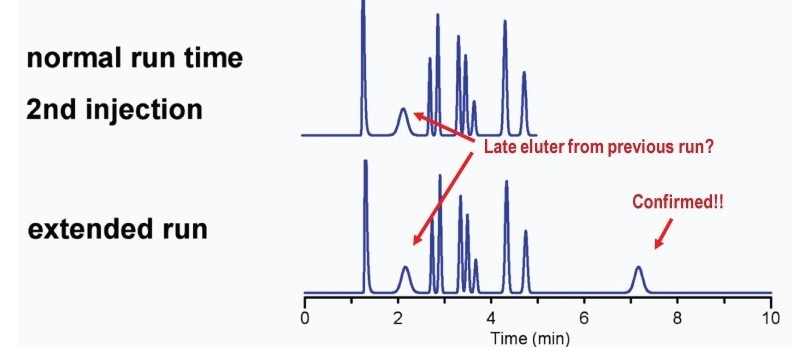A reader asks, “I have a nice isocratic method for compound A, which elutes at about 8 min, so I can inject a new sample every 10 min. Occasionally, however, my samples contain another compound B that comes out at about 40 min. I have no way of knowing in advance if B will be present or not. Some people in the lab are telling me that I need to wait 40 min for every sample to be sure that this peak is not present before I can inject again. This seems like a lot of wasted time. Can’t I just reinject the sample when B shows up in the wrong place in its chromatogram? After all, the B peak is pretty broad and easy to recognize.
Another way to think about this is illustrated in Figure 1, where a broad peak at about 2 min in the top chromatogram is clearly out of place. Whether you are doing isocratic or gradient runs, all the peaks in a particular region of the chromatogram should have about the same width. By extending the run, the peak shows up in the proper position (just after 7 min in the lower chromatogram), so the 2-min peak is from the previous injection.

Figure 1
There are several ways to address this problem. My preferred procedure for the present case would be to put a strong-solvent flush in the programme just after the peak of interest elutes. For example, if the normal mobile phase contained 20% methanol (MeOH), at 10 min, I’d switch to 90% MeOH for a couple of minutes, then drop back to 20% for a few more minutes to re-equilibrate before the next injection. This should flush any strongly retained materials, such as B from the column and ready the system for the next sample. There would be no confusion or surprise with extra peaks in chromatograms where they didn’t belong. The run time would be a little longer, but both the flush and re-equilibration steps could be accelerated if the flow-rate is increased during this time.
The method suggested by the reader is to re-run the sample in which the 40-min peak appeared. This could work, but if the peak has a retention time of exactly 40 min, it should come out 2 min after A in the third run after its sample was injected. If B is well separated from A, as the broad peak is at 2 min in Figure 1, there may not be any problem created, so the peak can be ignored. If it eluted close enough to A that there was interference, then the last sample could be ignored and re-injected. Another alternative might be to adjust the run time slightly, for example to 11 min instead of 10, so that when B appeared, it was well away from A. Or as the other people in the lab suggest, each run could be extended to 40 min, but that seems like a lot of wasted time to me.
A final technique that might work is to remove B during sample clean-up. This would likely be a lot of work and might require much more revalidation than the alternatives discussed above. Whatever choice is made, remember to document in writing what you are going to do when this problem occurs, get it approved by your quality assurance group, and then follow the process you created.
This blog article series is produced in collaboration with John Dolan, best known as one of the world’s foremost HPLC troubleshooting authorities. He is also known for his research with Lloyd Snyder, which resulted in more than 100 technical publications and three books. If you have any questions about this article send them to TechTips@sepscience.com
